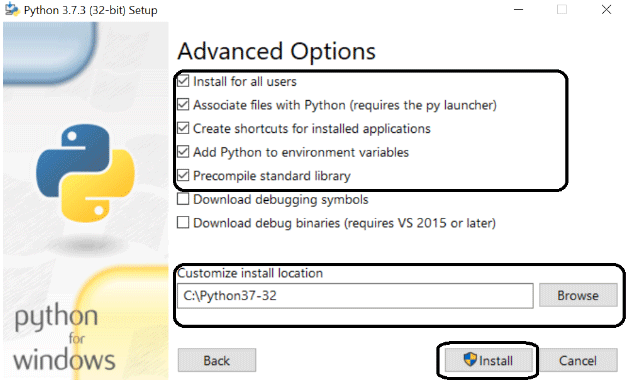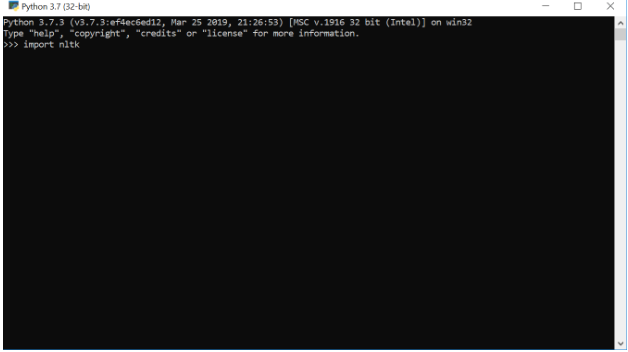Updated March 15, 2023
How to Install NLTK?
The following article Install NLTK provides an outline for installing NLTK. NLTK is a set of libraries for Natural Language Processing. It is a platform for building Python programs to process natural language. NLTK is written in the Python programming language. Steven Bird and Edward Loper developed it. It supports research and teaching in NLP or closely related areas, including cognitive science, empirical linguistics, information retrieval, artificial intelligence, and machine learning. NLTK provides an easy to use interface.
NLTK (Natural Language Toolkit)
- Natural language processing(NLP) is a part of artificial intelligence that processes humans’ language. Thus, it helps humans interact with computers even if they don’t know how to use them. Using NLP, humans just need to dictate the command to computers. With the power of Machine learning, Natural Language Processing is becoming popular and easier to implement. It is basically the technique to interact with humans and perform actions on voice commands.
- This enables devices to be used by even the novice who has no knowledge of technology. But the implementation of natural language processing is not easy, as a language spoken by Humans has no definite structure. It is ambiguous and depends on context words that can have a different meaning.
- NLTK has more than 50 corpora and lexical sources such as WordNet, Problem Report Corpus, Penn Treebank Corpus, etc. It also comes with a guidebook that explains the concepts of language processing by toolkit and programming fundamentals of Python, which makes it easy for people who have no deep knowledge of programming. It has a wide range of packages which makes it one of the powerful toolkits for NLP. Tokenization, Lemmatization, Stemming, Parsing, Character count, Punctuation, word count are some of these packages.
Install NLTK for Windows
Below are the instructions to Install NLTK in Windows. These are based on the assumption that Python is not installed in the system. NLTK requires Python versions 2.7,3.5, and above.
Step 1: Download the latest version of Python for Windows from the below link
https://www.python.org/downloads/
Step 2: Click on downloaded .exe to run it.
Step 3: Select the customize installation.
Step 4: Check for all the features, especially “pip”, as it helps to install NLTK and click on Next.
Step 5: In the next screen, select advanced options, select the path and click on install.
Step 6: Once the installation is successful, close to the window.
Step 7: Copy the path of the Scripts folder to install NLTK in the same folder.
NLTK can be easily installed using a “pip” installer. Also, we have to install “numpy” as well.
Step 8: To install NLTK, open the command prompt and type the below command.
Make sure the installation is successful.
After successful installation, now its time to use the NLTK for Natural Language Processing.
Step9: Open Python Shell and type the below command.
If it is imported without any error, that means NLTK is installed properly.
Install NLTK for Mac/Linux
Unlike in Windows, Linux systems come up with Python installed in it. To install NLTK in Linux/Mac, Python’s Pip package installer is used. In order to install pip or update it type the below commands in the command prompt.
To install python in Linux, use the below commands.
Step1: To update the package index use the below command.
Step2: To install Python in the Linux system, use the below.
Step3: Type in the below command to install “pip” for Python 3.
Step4: After “Pip” is installed successfully, use the following commands to install NLTK.
NLTK Dataset
NLTK has many datasets available for Natural language processing, for example, WordNet, WikiCorpus, Gutenberg, Opinion Lexicon, Tweebank, etc. These datasets are called corpora. Basically, the NLTK dataset contains a set of files or documents. Every file/ document contains a collection of words, letters or text in a single language. Thus, a corpus is mainly libraries for understanding/learning a language. It has rules of grammar and structure of a language.
After successfully installing NLTK, you can import it and also download its corpora with the following command.
NLTK downloader opens a window to download the datasets. The size of the dataset is big; hence it will take time. To test if datasets are installed properly, try importing the dataset and use it.
Processing of NLTK
There are 5 main processes of Natural Language Processing. These are the steps involved in processing any text.
- EOS Detection: End of speech detection breaks the text into a collection of meaningful sentences. It divides the long text into parts that have some meaning.
- Tokenization: This step splits the sentences into tokens. Tokens don’t only contain words but also includes whitespaces, sentence breaks.
- POS tagging: POS means pat-of-speech. Here, information is assigned to the token. This information suggests what type of speech it is as tense, verb, adjective, noun, etc.
- Chunking: Chunking means collecting text-based on tags.
- Extraction: Extraction is an ongoing process of going through chunks and tagging them as named entities like people, locations, organizations, etc.
Conclusion
NLTK is used for text classification, image captioning, speech recognition, question answering, language modelling, document summarization, and many other operations. There are many other tools for natural language processing. But NLTK has a wide range of libraries, making it one of the powerful natural language processing tools. It is more accurate than any other tool, but it is a bit slow because of the large number of libraries. So, it all depends on the user’s requirements. If the user wants speed, they can prefer other tools, but then they will have to compromise with the content’s accuracy. But if accuracy is a priority, then they should definitely go for NLTK.
Recommended Articles
This has been a guide to Install NLTK. Here we discuss the basic concept and different steps to install NLTK on Windows and Linux\Mac. You may also look at the following articles to learn more-
















